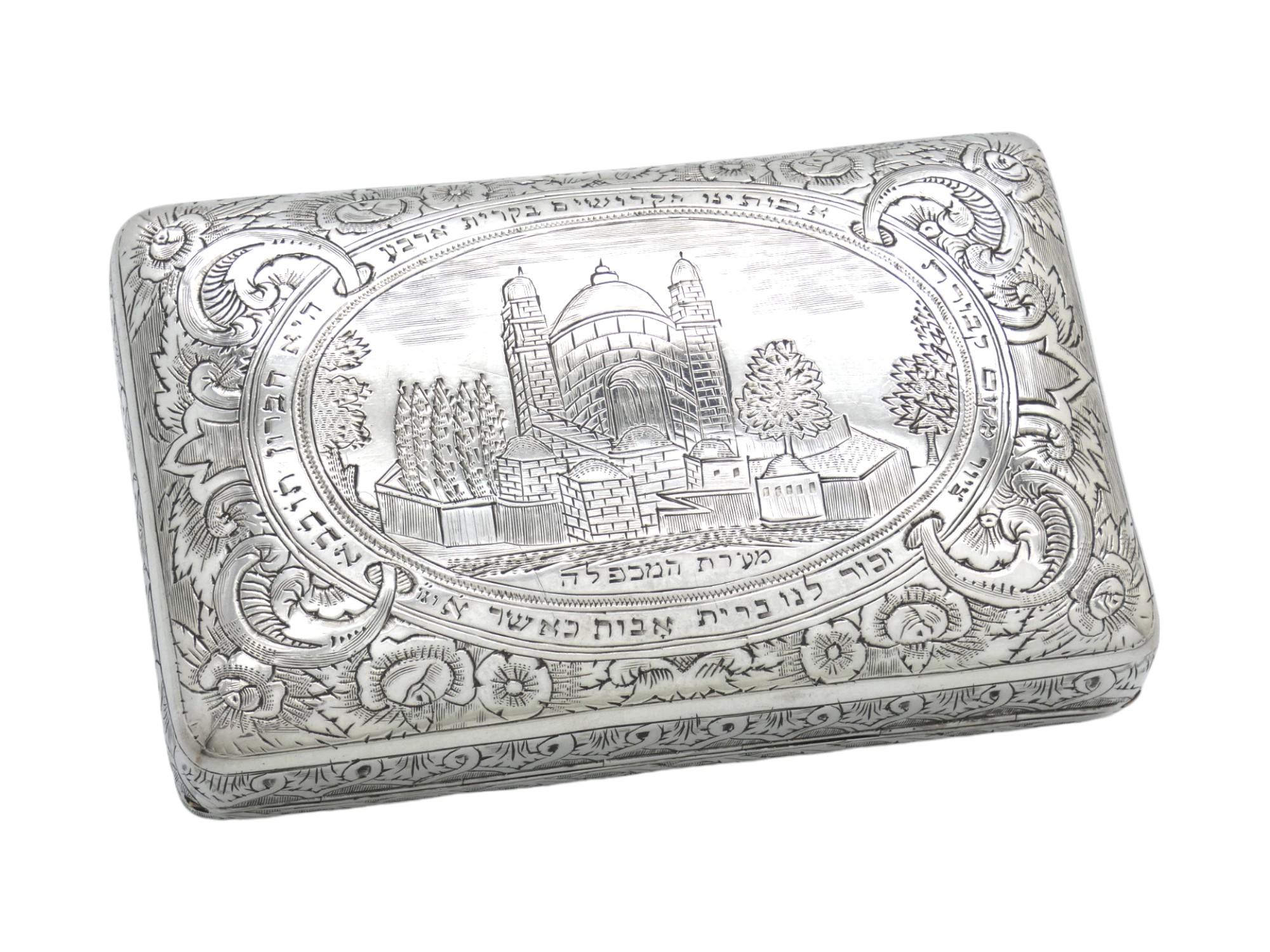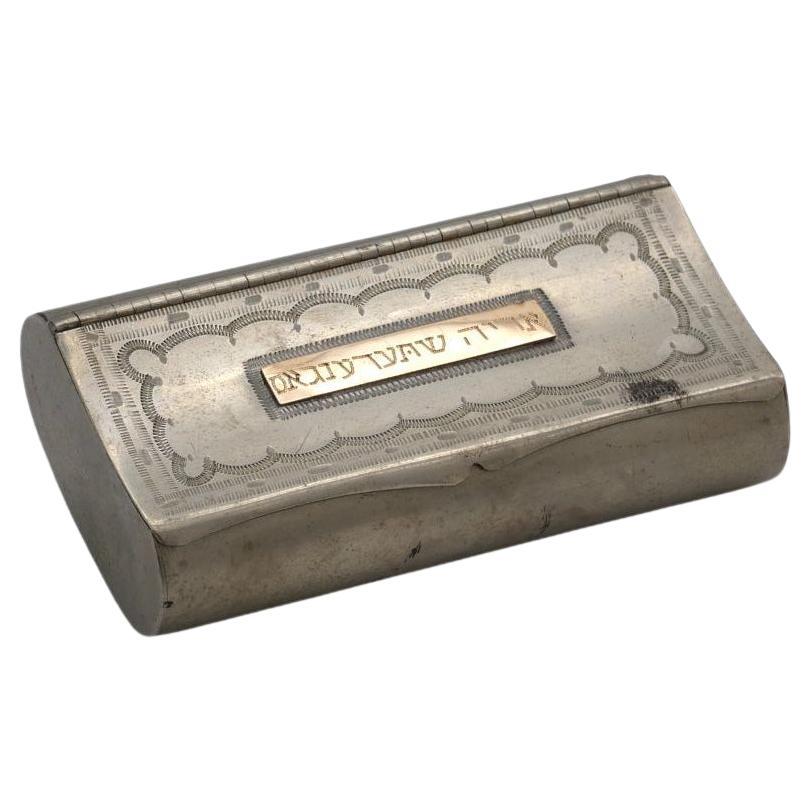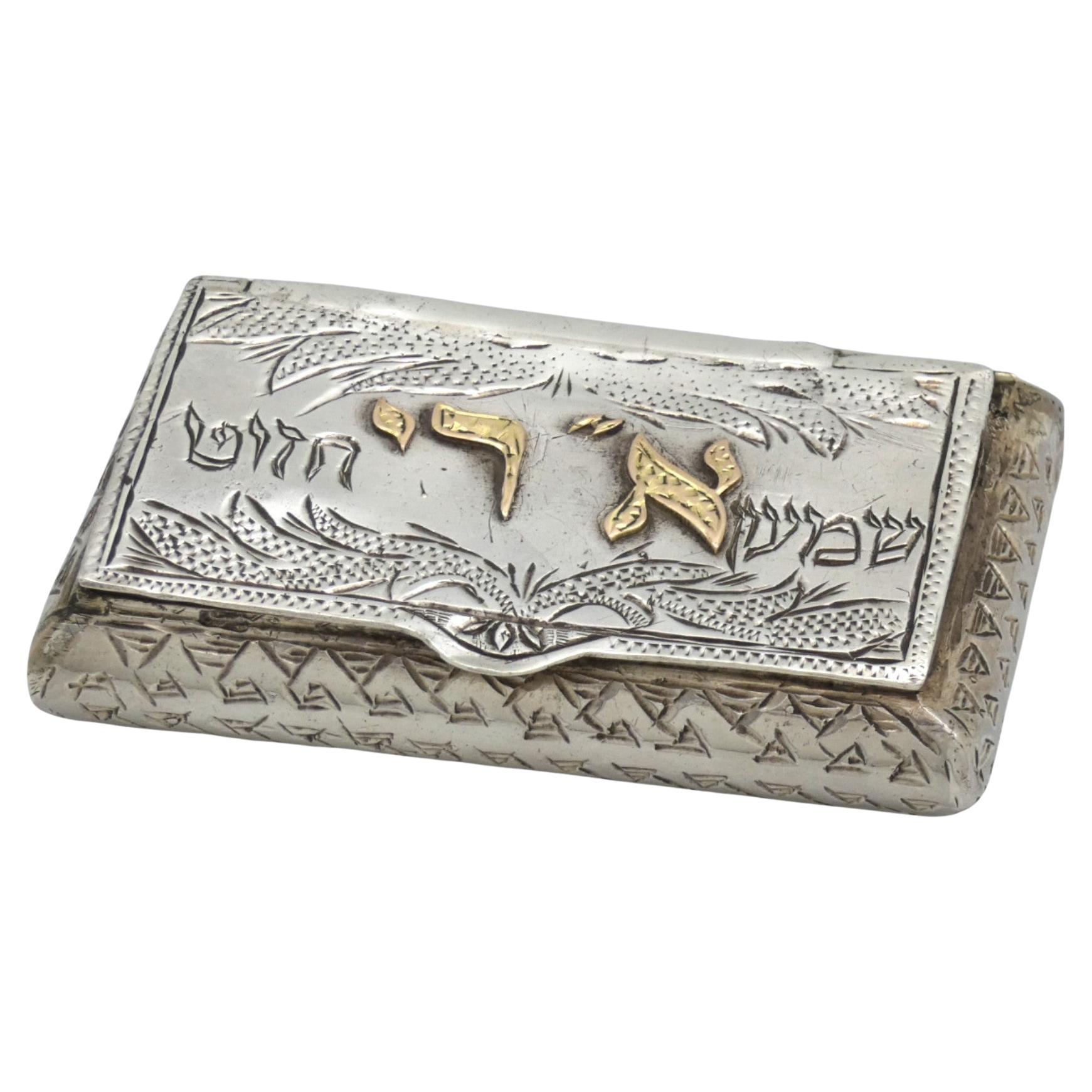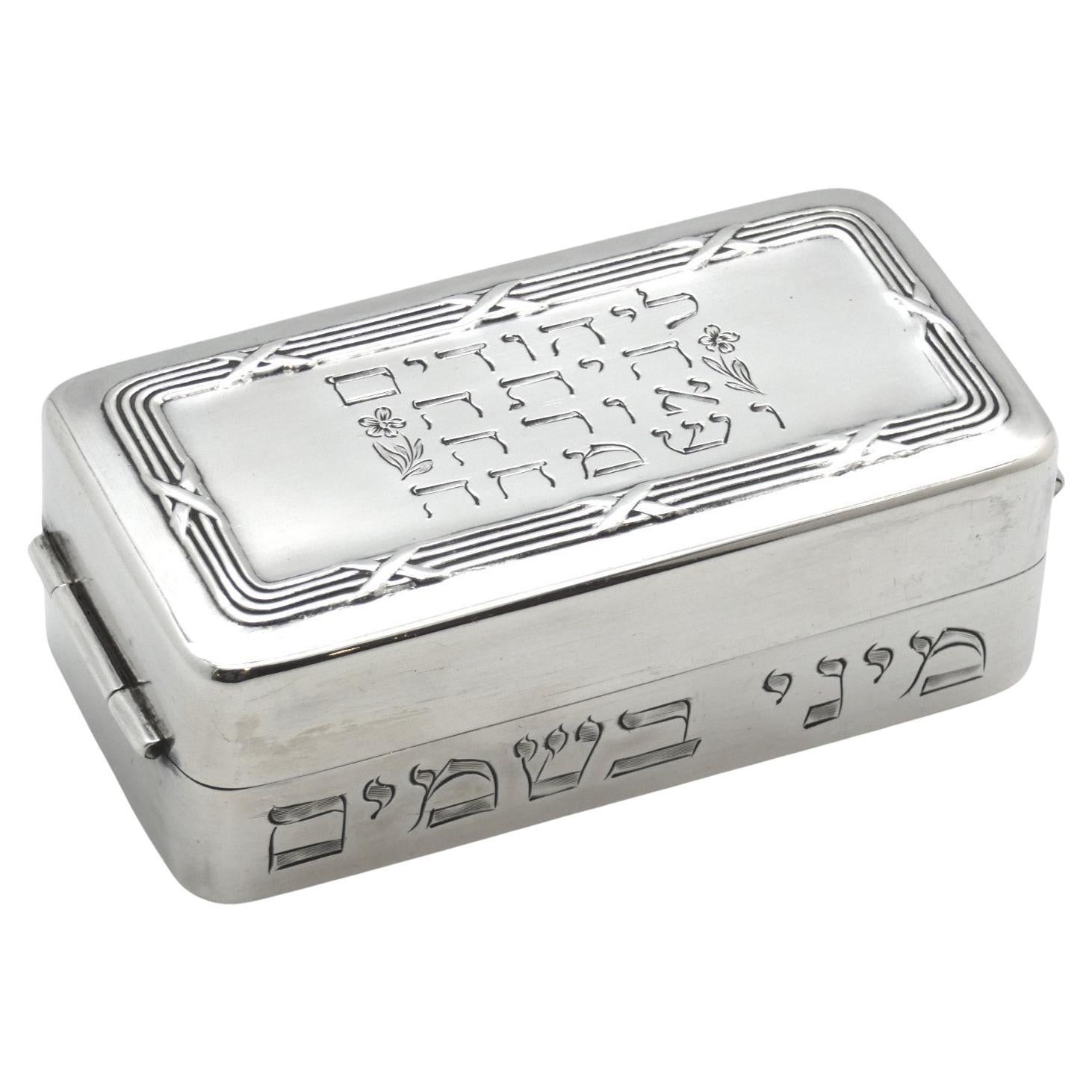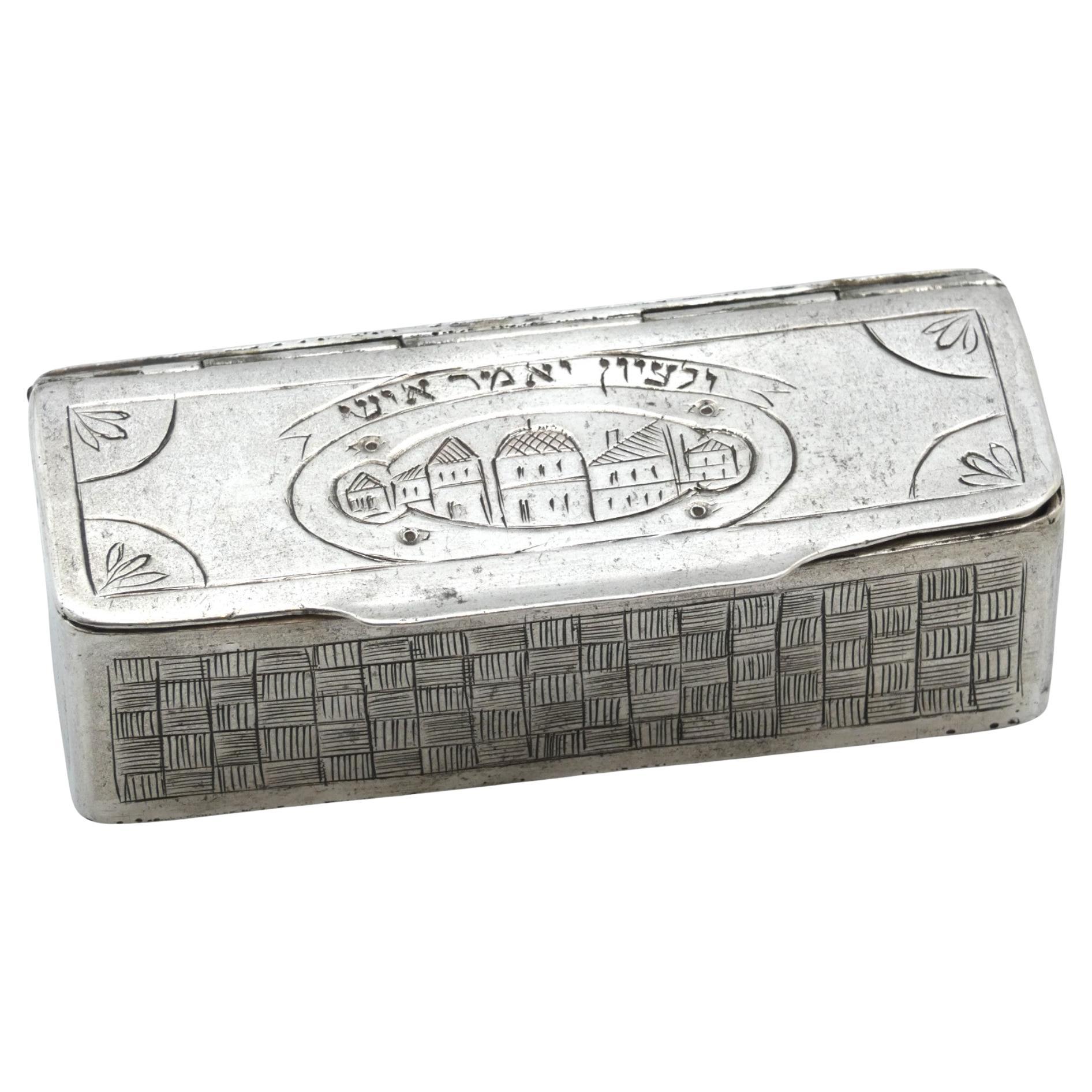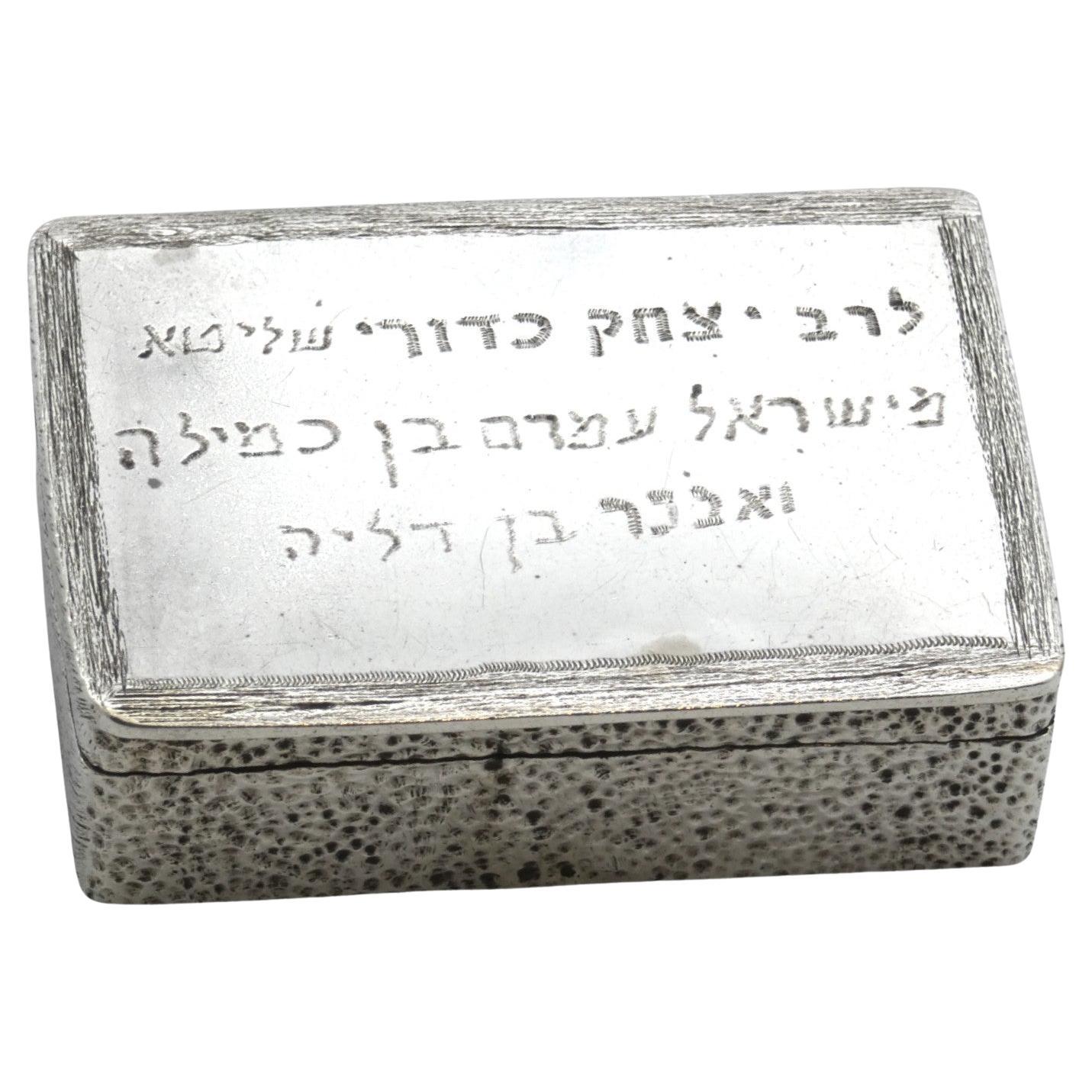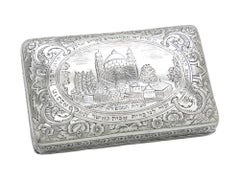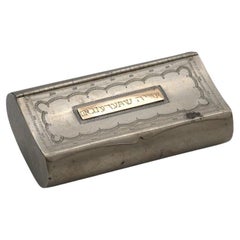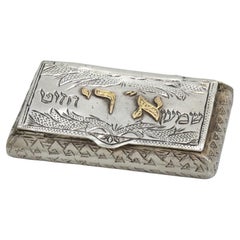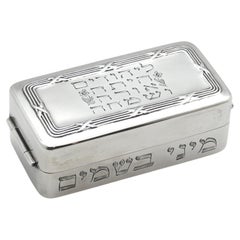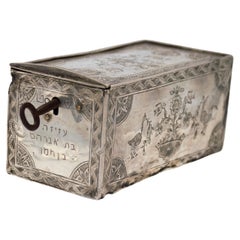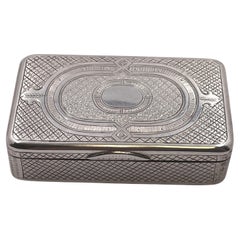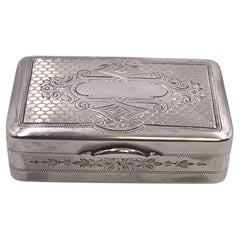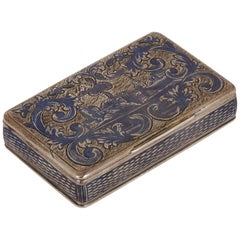Items Similar to A Large Silver Russian Snuff Box, Late 19th Century. Hebrew - Judaica
Want more images or videos?
Request additional images or videos from the seller
1 of 6
A Large Silver Russian Snuff Box, Late 19th Century. Hebrew - Judaica
$2,800
$3,50020% Off
£2,111.92
£2,639.9020% Off
€2,439.29
€3,049.1220% Off
CA$3,922.99
CA$4,903.7420% Off
A$4,362.14
A$5,452.6820% Off
CHF 2,283.66
CHF 2,854.5820% Off
MX$53,284.39
MX$66,605.4920% Off
NOK 28,696.45
NOK 35,870.5620% Off
SEK 26,994.76
SEK 33,743.4520% Off
DKK 18,209.15
DKK 22,761.4420% Off
About the Item
This large Russian silver snuff box from the late 19th century is a finely crafted and substantial piece, reflecting the opulence and attention to detail typical of the period. The hinged lid is intricately engraved with elaborate patterns, featuring foliate designs, and scrolling motifs that highlight the artistry of Russian silversmiths of this era who were renowned for their attention to detail.
The snuff box's craftsmanship is elegant and sturdy, with smooth, rounded edges and a finely polished interior. The hinged lid has a snug fit and is adorned with beautiful foliage and scrolling engravings. A central cartouche features an engraved monogram stating that this snuff box was given as a gift to a groom, "Binyamin Zalman) atop the groom's father's name, "R' Mordechai Tzvi" and concludes that he was of Priestly heritage ("Kohen").
At the center of the cartouche, a pair of hands are spreading upward in the "Duchening" fashion which is a Yiddish term for the practice of Kohanim (Hebrew priests) reciting the Priestly Blessing to the Jewish people. Framed at each side of the priestly hands are two trees which symbolize the sanctity of marriage and a blessing for the newlywed couple to be prosperous.
Hallmarked at the inner part of the hinged lid, and on the bottom of the snuff box.
- Dimensions:Height: 0.99 in (2.5 cm)Width: 3.82 in (9.7 cm)Depth: 2.37 in (6 cm)
- Materials and Techniques:Silver,Engraved
- Place of Origin:
- Period:
- Date of Manufacture:19th century
- Condition:Wear consistent with age and use.
- Seller Location:New York, NY
- Reference Number:1stDibs: LU5281241345182
About the Seller
5.0
Recognized Seller
These prestigious sellers are industry leaders and represent the highest echelon for item quality and design.
Established in 2006
1stDibs seller since 2020
134 sales on 1stDibs
Typical response time: 8 hours
- ShippingRetrieving quote...Shipping from: Pomona, NY
- Return Policy
Authenticity Guarantee
In the unlikely event there’s an issue with an item’s authenticity, contact us within 1 year for a full refund. DetailsMoney-Back Guarantee
If your item is not as described, is damaged in transit, or does not arrive, contact us within 7 days for a full refund. Details24-Hour Cancellation
You have a 24-hour grace period in which to reconsider your purchase, with no questions asked.Vetted Professional Sellers
Our world-class sellers must adhere to strict standards for service and quality, maintaining the integrity of our listings.Price-Match Guarantee
If you find that a seller listed the same item for a lower price elsewhere, we’ll match it.Trusted Global Delivery
Our best-in-class carrier network provides specialized shipping options worldwide, including custom delivery.More From This Seller
View AllA Fantastic Silver Snuff Box, Jerusalem late 19th Century. Hebrew judaica
Located in New York, NY
A beautifully engraved silver snuff box from Jerusalem from the late 19th century is finely crafted and is a piece that reflects the rich cultural heritage and craftsmanship of the r...
Category
Antique Late 19th Century Israeli Rococo Sterling Silver
Materials
Silver
$18,000 Sale Price
20% Off
An Engraved Pewter Snuff Box, Circa 1900 Judaica
Located in New York, NY
This charming engraved pewter snuff box, dating to circa 1900, is a beautifully preserved example of everyday Judaica—a personal object once carried a...
Category
Antique Early 1900s Polish Snuff Boxes and Tobacco Boxes
Materials
Pewter
A Silver and Gold Moroccan Snuff Box circa 1920
Located in New York, NY
A silver and gold Moroccan snuff box from circa 1920 is a stunning example of North African craftsmanship, blending traditional Berber and Islamic design...
Category
Vintage 1920s Moroccan Sterling Silver
Materials
Silver
$2,400 Sale Price
20% Off
A Silver German Havdalah Spice Box, Early 20th Century
Located in New York, NY
A silver German spice box from the early 20th century is a finely crafted, understated yet elegant piece that reflects the high level of craftsmanship typical of German silversmiths during this period.
The box is rectangular, with smooth silver surfaces and the design leans toward simplicity, characteristic of the early 20th century's shift toward Art Deco or late Jugendstil (German Art Nouveau) influences. The hinged lid features clean geometric patterns that frame the engraving written in Hebrew at the center flanked by flower engravings and securely closes over the compartment with a latch that holds the fragrant spices. The sides of the spice box are beautifully engraved with more Hebrew verses relating to the blessings of the spices and flanked by flower motifs. The overall structure is delicate yet sturdy, reflecting the precision and skill of early 20th-century German Judaica...
Category
Early 20th Century German Sterling Silver
Materials
Silver
$2,400 Sale Price
20% Off
A Silver Snuff Box Sadagura, Ukraine Circa 1880
Located in New York, NY
A silver snuff box from Sadagura, Ukraine, circa 1880, is a distinctive piece reflecting the regional craftsmanship and style of the late 19th century.
SADAGORA (Rom. Sadagura ; Ge...
Category
Antique 1880s Ukrainian Sterling Silver
Materials
Silver
$4,800 Sale Price
20% Off
A Silver Snuff Box Belonging to the Holy Mekubal Harav Yitzchak Kaduri
Located in New York, NY
A Silver Snuff Box Belonging to the Holy Mekubal Harav Yitzchak Kaduri.
The Kabbalist Rabbi Yitzhak Kaduri was born at the end of the 19th Century in Iraq, studied Torah and Kabbala...
Category
20th Century Sterling Silver
Materials
Silver
$5,600 Sale Price
20% Off
You May Also Like
extremely rare Algerian Judaica silver, jewish Dowry box early 19th century
Located in Tel Aviv - Jaffa, IL
Amazing and scarce JUDAICA object, we have here one of the most touching jewish objects we had for a long time, this small silver dowry box was made in Algeria in the early 19th century, it is all covered with symbols of jewish faith and of couples, the sliding lid has 2 flanking birds with hamsa (protective hand) on each side and a flower vase in the middle.
one side shows two flanking lions with a tree in the middle and the other side shows again two big and two small birds with a flower bowl in the middle, front side has a key hole and next to it there is the Hebrew inscription ס״ט״" which says Siman tov or in English "a good sign" it is taken from the wedding blessing, underneath the lock there is another inscription with the name ״עזיזה בת אברהם בן חמו״ which is the name of the bride, her father and her grandfathers name.
the box is full marked a lot of times with the silversmith mark, every side of the box is marked.
this box was probably ordered by the grooms family to hold the jewelry they are giving to the bride as dowry, this type of objects are rare and there are just a few of them on museum collections.
DOWRY (Heb. נְדֻנְיָה), the property a wife brings to her husband at marriage; the Yiddish equivalent, nadn, is from the same root. The custom of nedunyah became clearly defined and institutionalized only in the talmudic period. In biblical times, mohar (מֹהַר), whereby the groom bought his wife from her father (Gen. 24:53; Ex. 22:15–16; Hos. 3:2), was the accepted practice. It was then customary that the groom give the bride gifts, and that she bring certain property to her husband's home upon marriage: slaves, cattle, real estate, etc. (cf. Gen. 24:59–61; 29; Judg. 1:14ff.; I Kings 9:16). Evidence of the custom of nedunyah is to be found in Tobit (7:14; 8:21) and in the Assuan papyri (Cowley, Aramaic, nos. 15, 18). Gradually, mohar was superseded by the ketubbah custom according to which the husband merely assumed the responsibility of compensation to his wife in case he divorced her: he had to pay her 200 zuzim if she had been a virgin at the time of marriage, and 100 zuzim if a widow or divorcée (see *Ketubbah).
By talmudic times, the institution of nedunyah was prevalent; the father gave a dowry to the bride since the daughter was excluded from paternal inheritance. Fifty zuzim (equivalent to the worth of 180 grams of silver) was the minimum amount a father was obliged to give to his daughter (Ket. 6:5). Parents usually gave much more, according to their social standing. Community funds provided the dowry for an orphan or a very poor girl (ibid.; cf. Sh. Ar., YD 251:8). In case of her father's death, the brothers of a minor girl were obliged to give her the minimum dowry, and the court estimated how much her father would have given her above the minimum dowry. The sum was then taken out of the father's estate and given to the daughter upon majority (Ket. 6:6; 68a–69b). In the absence of such an estimate, each daughter was entitled to receive one-tenth of the value of her father's estate in money, or in valuables (Yad, Ishut, 20:4–7; Sh. Ar., EH 113:4). If the father was unable or unwilling to pay the promised dowry at the betrothal ceremony, the groom could refuse to marry his bride (Ket. 13:5; Ket. 108b–109a). Insistence on exact payment of the promised dowry, however, was frowned upon by later rabbinic authorities (Rema to Sh. Ar., EH 2:1). In certain communities it was customary for the groom's father to make a dowry contribution equal to that of the bride's father (Ket. 102b). The dowry, whether given in real estate, slaves, money, or chattel was recorded in the marriage contract (the ketubbah) and in some instances one-third or one-fifth of the actual value of the dowry was added to the sum mentioned in the ketubbah. Based upon a decree enacted by *Simeon b. Shetah (first century C.E.), the Talmud ruled that the husband and his entire property were liable for compensation as stipulated in the ketubbah, either in case he died (when she collected the sum specified in the ketubbah from the heirs) or in case he divorced his wife (Ket. 82b). For the status of the dowry and the husband's rights and obligations, see below. The rabbinic enactments (Takkanot Shum) by R. Jacob *Tam and by the rabbinic synod of the communities of Speyer, Worms, and Mainz (Germany) stipulated that if a woman died...
Category
Antique Mid-19th Century Algerian Tribal Art
Materials
Silver
Russian Silver Snuff Box from 1872
Located in New York, NY
Russian silver snuff box from 1872, gilt inside, with beautifully diapered and geometric designs. It measures 2 7/8'' in depth by 1 3/4'' in width by 3/4'' in height, weighs 3 troy o...
Category
Antique 1870s Russian Snuff Boxes and Tobacco Boxes
Materials
Silver
Gorham Silver Snuff Box from Mid-19th Century
By Gorham
Located in New York, NY
Gorham silver snuff box from the mid-19th century, gilt inside, with beautifully diapered and geometric designs. It measures 3 1/8'' in depth by 1 7/8'' in width by 7/8'' in height, ...
Category
Antique Mid-19th Century American Decorative Boxes
Materials
Silver
Antique Russian Silver Niello Snuff Box with Rectangular Hinged Lid
Located in London, GB
Scene of Russian town surrounded by floral detailing on lid, lozenge design to sides.
Category
Antique Mid-19th Century Russian Snuff Boxes and Tobacco Boxes
Materials
Silver
$717 Sale Price
20% Off
19th Century French Silver Snuff Box
Located in Delft, NL
19th century French silver snuff box
Late 19th century silver snuffbox with engraved centre and gilt interior
Hall marked by the Silversmith, Dubois Leon & Bauve Henri
The Dutch...
Category
Antique 19th Century French Snuff Boxes and Tobacco Boxes
Materials
Silver
19th Century English Long Silver Trinket Box
Located in Marbella, ES
19th century English long silver trinket box.
Category
Mid-20th Century English Snuff Boxes and Tobacco Boxes
Materials
Silver
More Ways To Browse
Large Sterling Silver Box
Russia Silver Box
Russian Snuff Box
Russian Silver Snuff Box
Antique Russian Snuff Box
Vintage Sterling Silver Bottle Opener
950 Japan
Antique Pie Plate
Antique Silver Chatelaine
Antique Silver Coffee Server
Antique Towle Silver
Bar Spoon Sterling Silver
French Sterling Coffee Pot
Hanau 800
Oyster Bowl
Puiforcat Silver Plate
Tiffany Berry
Tiffany Demitasse
